Winding in a winter wonderland
Grass key to southern bass action during colder months
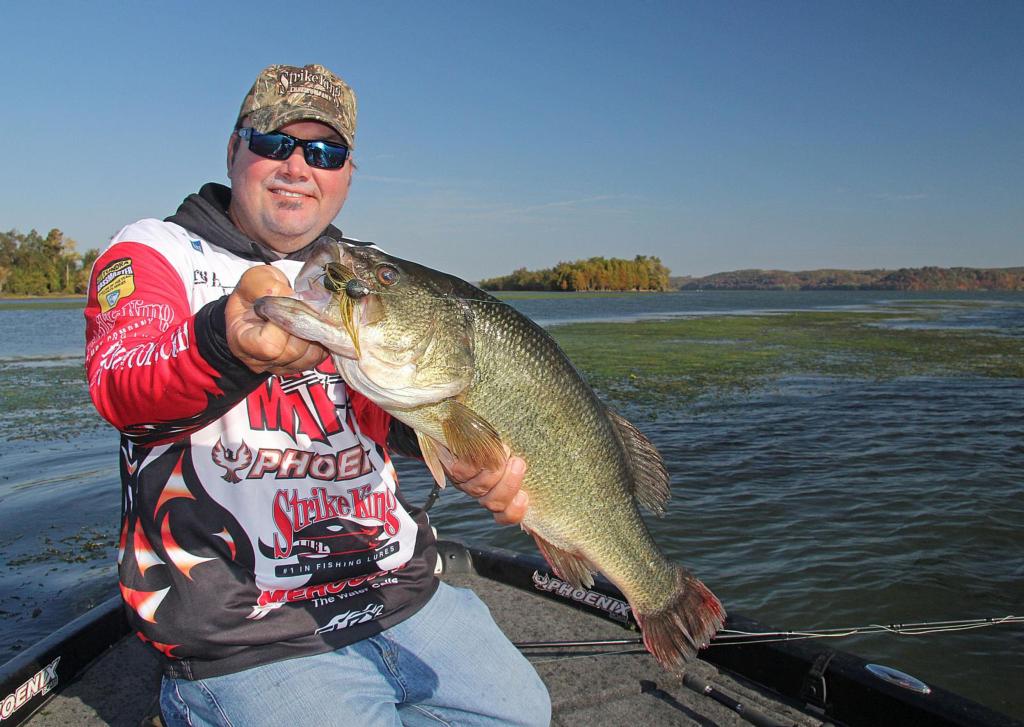
The etiquette police tell us it's not nice to gloat, so it wouldn't be right for southern anglers to brag about their bass fisheries, which remain viable while ice impounds those of their northern angling brethren. The right thing, the polite, if not factually correct thing, to do would be to simply point out that one of the major elements of cold season action is the presence of grass. Aquatic weed beds that last through mild winters on bass Meccas like Kentucky Lake, Toledo Bend, Amistad, Okeechobee and tidal waters like the Potomac River offer strategic cover, warmth and feeding opportunities. Winter's severity will determine how much "old" grass survives to meet spring's new growth and the 2012-2013 season has thus far proven kind in that regard. On southern reservoir lakes (the Tennessee River, for example), flood waters can keep sunlight from stimulating new warm season growth, while years of moderate water levels see hydrilla beds holding much of their mass throughout the cold season. A few things are certain. First, there will always be some level of die back, as the combination of shorter daylight periods and lower temperatures take their toll of sub aquatic vegetation. Potomac River guide Steve Chaconas said most of the river's coontail and hydrilla dies off annually, but some subaquatic vegetation remains, provided the region gets sufficient rain to keep saltwater intrusion at bay. A dry summer, followed by a dry winter can spell doom for freshwater grasses all the way up to the D.C. area. 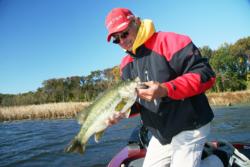 "Milfoil dies back with a limited amount remaining dormant during the winter," he said. "This is a function of the overall health of the grass and water clarity from November through February. With the shortest days and least amount of sunlight occurring in December, any grass that is still green will have a better chance to survive as days become longer and provide more sunlight to reach the grass – depending on water clarity. I take note of these areas while fishing in December and seek them out in February as these areas will green up and hold fish in the late winter/early spring as fish move out of winter haunts." Second, the remaining grass presents diminished habitat and that often means more bass in tighter confines. While there are no guarantees, greater feeding competition is a good thing. Finally, expect sluggish-to-slow activity during the routine cold spells. Even in southern climes, bass won't have that pep in their step for another month or two, so ease back on the throttle and fish patiently. Find the sweet spots Making his home in Boca Raton, Fla., Mike Surman notes that hydrilla remains thick pretty much year round in his home state. There's not much growth in the winter months, but plenty of cover remains. In Florida and other southern waters, he said, shallow hydrilla often will hold its bottom connection as long as it gets plenty of sunshine; whereas deeper grass typically loses some of its mass during winter. "A lot of times, the hydrilla in deeper water will drop its stems and then it has a lot of space below," Surman said. "The wind will blow some of that loose hydrilla into the shallow (rooted) grass and add to the (density)." Former Forrest Wood Cup champion Greg Hackney said that fish relating to winter grass will tuck deep into the cover during cold spells, but warmer conditions will find them positioned along the edges similar to their fall feeding fest. Grass that remains close to the surface easily reveals all the key spots – points, dips and interior holes indicating rocks or stumps on the bottom. When grass partially recedes, Hackney said previous observations benefit current objectives. "In the fall, when the grass has a tendency to mat up, you can see the turns, you can see all the drains and you can learn a lot about the area when the grass is growing – you know exactly how it lays out," he said. "Even during the time of the year when it's down, you can pull up there and know how the place sets up."
"Milfoil dies back with a limited amount remaining dormant during the winter," he said. "This is a function of the overall health of the grass and water clarity from November through February. With the shortest days and least amount of sunlight occurring in December, any grass that is still green will have a better chance to survive as days become longer and provide more sunlight to reach the grass – depending on water clarity. I take note of these areas while fishing in December and seek them out in February as these areas will green up and hold fish in the late winter/early spring as fish move out of winter haunts." Second, the remaining grass presents diminished habitat and that often means more bass in tighter confines. While there are no guarantees, greater feeding competition is a good thing. Finally, expect sluggish-to-slow activity during the routine cold spells. Even in southern climes, bass won't have that pep in their step for another month or two, so ease back on the throttle and fish patiently. Find the sweet spots Making his home in Boca Raton, Fla., Mike Surman notes that hydrilla remains thick pretty much year round in his home state. There's not much growth in the winter months, but plenty of cover remains. In Florida and other southern waters, he said, shallow hydrilla often will hold its bottom connection as long as it gets plenty of sunshine; whereas deeper grass typically loses some of its mass during winter. "A lot of times, the hydrilla in deeper water will drop its stems and then it has a lot of space below," Surman said. "The wind will blow some of that loose hydrilla into the shallow (rooted) grass and add to the (density)." Former Forrest Wood Cup champion Greg Hackney said that fish relating to winter grass will tuck deep into the cover during cold spells, but warmer conditions will find them positioned along the edges similar to their fall feeding fest. Grass that remains close to the surface easily reveals all the key spots – points, dips and interior holes indicating rocks or stumps on the bottom. When grass partially recedes, Hackney said previous observations benefit current objectives. "In the fall, when the grass has a tendency to mat up, you can see the turns, you can see all the drains and you can learn a lot about the area when the grass is growing – you know exactly how it lays out," he said. "Even during the time of the year when it's down, you can pull up there and know how the place sets up." 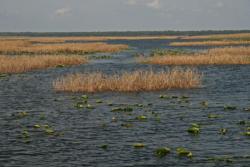 Lakes spanning from central to southern Florida are blessed with vast stands of Kissimmee grass, a perennial thin blade species of emergent vegetation that offers prime habitat throughout much of the year. Often growing in large offshore stands, sometime mixing with lily pads, Kissimmee grass typically grows on hard sand bottoms, so this is prime spawning habitat. During prespawn, you can often find staging fish feeding heavily around the edges of this distinctive vegetation. On the move
Lakes spanning from central to southern Florida are blessed with vast stands of Kissimmee grass, a perennial thin blade species of emergent vegetation that offers prime habitat throughout much of the year. Often growing in large offshore stands, sometime mixing with lily pads, Kissimmee grass typically grows on hard sand bottoms, so this is prime spawning habitat. During prespawn, you can often find staging fish feeding heavily around the edges of this distinctive vegetation. On the move 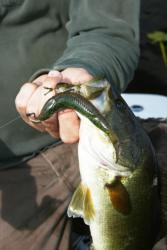 One of the best ways to search broad areas of grass is a long cast, using a high rod angle and a steady topside retrieve with swimming plastics like the Reaction Innovations Skinny Dipper, Berkley Havoc Grass Pig or Strike King Swim'n Caffeine Shad rigged on a wide gap hook. Trading the swimming action for a dart and twitch retrieve, a Texas-rigged Senko, Yum Dinger or Wave Worms Tiki Stick can lead to successful results as well. With either bait style, add a light bullet weight for deeper running over grass that has retreated from the surface. Another trick for either bait – swim or twitch it across the grass and then kill it over gaps in the cover, or right at the edges. This falling look represents and easy meal – especially attractive when late-season cold snaps slow the bite. In Kissimmee grass, pitch your soft stick baits into gaps in the cover. Lipless crankbaits like a Spro Aruku Shad or Strike King Redeye Shad are a grass line favorite, particularly for targeting southern prespawners staging for their shoreward move. Mix in a little wood and squarebills like the Luck "E" Strike RC2 and River2Sea Ish Monroe Biggie and you can do quite well. "In lakes where the hydrilla (partially) dies back, I like throwing a Spro Rattl'n Vibe and ripping it through the grass," Surman said. "You may be in 6 feet of water, but the grass only comes up maybe 3 feet. You throw that bait over the grass and it will actually hang on the grass. You rip it free and most of your strikes will come right as the bait rips out of the grass.” Spinnerbaits can be productive, especially when slow-rolled around grass edges. On warmer days, the flash of gold and silver willow leaf blades stimulates feeding with a killer shad impersonation, while the thump of Colorado blades may be just the thing to coax a reluctant fish out from the vegetation.
One of the best ways to search broad areas of grass is a long cast, using a high rod angle and a steady topside retrieve with swimming plastics like the Reaction Innovations Skinny Dipper, Berkley Havoc Grass Pig or Strike King Swim'n Caffeine Shad rigged on a wide gap hook. Trading the swimming action for a dart and twitch retrieve, a Texas-rigged Senko, Yum Dinger or Wave Worms Tiki Stick can lead to successful results as well. With either bait style, add a light bullet weight for deeper running over grass that has retreated from the surface. Another trick for either bait – swim or twitch it across the grass and then kill it over gaps in the cover, or right at the edges. This falling look represents and easy meal – especially attractive when late-season cold snaps slow the bite. In Kissimmee grass, pitch your soft stick baits into gaps in the cover. Lipless crankbaits like a Spro Aruku Shad or Strike King Redeye Shad are a grass line favorite, particularly for targeting southern prespawners staging for their shoreward move. Mix in a little wood and squarebills like the Luck "E" Strike RC2 and River2Sea Ish Monroe Biggie and you can do quite well. "In lakes where the hydrilla (partially) dies back, I like throwing a Spro Rattl'n Vibe and ripping it through the grass," Surman said. "You may be in 6 feet of water, but the grass only comes up maybe 3 feet. You throw that bait over the grass and it will actually hang on the grass. You rip it free and most of your strikes will come right as the bait rips out of the grass.” Spinnerbaits can be productive, especially when slow-rolled around grass edges. On warmer days, the flash of gold and silver willow leaf blades stimulates feeding with a killer shad impersonation, while the thump of Colorado blades may be just the thing to coax a reluctant fish out from the vegetation. 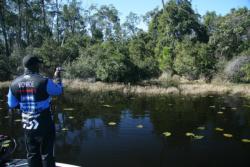 Also, don't rule out a hollow body frog for winter grass. Considering that big females will soon start packing their bellies for the prespawn bulk-up, a protein-rich frog ranks high on the menu. Remember, whatever baits you throw, keep them about half speed. Slow and plodding is the name of the game this time of year. On target In any season, you can't talk about grass without mentioning flipping tactics. Hackney said winter is actually his favorite time to flip grass because he finds the fish easier to target. Although the warmer months may find him seeking the fast-drop reaction bites with a 1-ounce Strike King Hack Attack jig or Texas-rigged Strike King Menace with an ounce of tungsten weight, he'll never go heavier than ¾ ounces in winter. In most scenarios, a 3/8- to ½-ounce bait is plenty. "The grass will open up so you're not fighting to get through it," he said. "Also, that heavy bait falls too fast. Those fish are more lethargic in the winter and a heavy bait spooks. They want something that falls slow and just kind of flutters. In the wintertime, 90 percent of it will be on the bottom." Hackney also slows his presentations by switching from an active trailer like a Rage Craw to a bulkier KVD Chunk. He gets more winter bites on the Chunk because the fish want a big profile, but minimal action.
Also, don't rule out a hollow body frog for winter grass. Considering that big females will soon start packing their bellies for the prespawn bulk-up, a protein-rich frog ranks high on the menu. Remember, whatever baits you throw, keep them about half speed. Slow and plodding is the name of the game this time of year. On target In any season, you can't talk about grass without mentioning flipping tactics. Hackney said winter is actually his favorite time to flip grass because he finds the fish easier to target. Although the warmer months may find him seeking the fast-drop reaction bites with a 1-ounce Strike King Hack Attack jig or Texas-rigged Strike King Menace with an ounce of tungsten weight, he'll never go heavier than ¾ ounces in winter. In most scenarios, a 3/8- to ½-ounce bait is plenty. "The grass will open up so you're not fighting to get through it," he said. "Also, that heavy bait falls too fast. Those fish are more lethargic in the winter and a heavy bait spooks. They want something that falls slow and just kind of flutters. In the wintertime, 90 percent of it will be on the bottom." Hackney also slows his presentations by switching from an active trailer like a Rage Craw to a bulkier KVD Chunk. He gets more winter bites on the Chunk because the fish want a big profile, but minimal action. 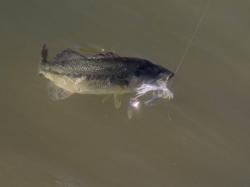 "The other deal that time of the year is it's all about fluorocarbon because I need that sensitivity," Hackney said. "Those fish are not always aggressive and a lot of times they just load up on the bait. To get a good hook set without stretching my line, I really like fluorocarbon. I can tell what my bait's doing and I can tell when I get those subtle bites. You get a lot of subtle bites that time of the year, especially when you're cranking a lipless crankbait. Then, all of sudden, it's just dead weight. So I need to react and get those hooks in the fish. "Another thing that happens in the cold water is that they're bodies are really hard,” Hackney continued. “They're bodies get soft when the water warms so they stick easier and they can get rid of the hooks easier. During winter, they have a tendency to be really hard, so that fluorocarbon allows me to get a good hook set."
"The other deal that time of the year is it's all about fluorocarbon because I need that sensitivity," Hackney said. "Those fish are not always aggressive and a lot of times they just load up on the bait. To get a good hook set without stretching my line, I really like fluorocarbon. I can tell what my bait's doing and I can tell when I get those subtle bites. You get a lot of subtle bites that time of the year, especially when you're cranking a lipless crankbait. Then, all of sudden, it's just dead weight. So I need to react and get those hooks in the fish. "Another thing that happens in the cold water is that they're bodies are really hard,” Hackney continued. “They're bodies get soft when the water warms so they stick easier and they can get rid of the hooks easier. During winter, they have a tendency to be really hard, so that fluorocarbon allows me to get a good hook set."